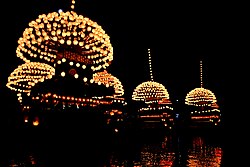Tsushima, Aichi
|
Tsushima 津島市 |
|||
|---|---|---|---|
| City | |||

Tsushima Tenno Festival
|
|||
|
|||
 Location of Tsushima in Aichi Prefecture |
|||
| Coordinates: 35°10′37.4″N 136°44′28.6″E / 35.177056°N 136.741278°ECoordinates: 35°10′37.4″N 136°44′28.6″E / 35.177056°N 136.741278°E | |||
| Country | Japan | ||
| Region | Chūbu (Tōkai) | ||
| Prefecture | Aichi Prefecture | ||
| Government | |||
| Area | |||
| • Total | 25.09 km2 (9.69 sq mi) | ||
| Population (May 2015) | |||
| • Total | 62,879 | ||
| • Density | 2,510/km2 (6,500/sq mi) | ||
| Time zone | Japan Standard Time (UTC+9) | ||
| - Tree | Pinus thunbergii | ||
| - Flower | Japanese wisteria | ||
| - Bird | Egret | ||
| Phone number | 0567-24-1111 | ||
| Address | 2-21 Tatekomi-chō, Tsushima-shi, Aichi-ken 496-8686 | ||
| Website | Official website | ||
Tsushima (津島市 Tsushima-shi?) is a city located in Aichi Prefecture in the Chūbu region of Japan.
As of May 2015, the city had an estimated population of 62,879 and a population density of 2,591 persons per km². The total area was 25.09 square kilometres (9.69 sq mi).
Tsushima is located in far western Aichi Prefecture.
Average winter temperatures range from around 0-10 degrees C with occasional snowfall. Summer is hot and humid with occasional typhoons. Summer temperatures are regularly around 30 degrees C. The East Asian rainy season occurs in June.
Tsushima developed as a monzen-machi catering to the pilgrimage traffic to the well-known Shinto shrine of Tsushima Jinja from the Muromachi period. During the Sengoku period, it was controlled by the Oda clan and subsequently in the Edo period was part of the holdings of the Owari Tokugawa of Nagoya.
During the Meiji period, the area was organized into several villages under Ama District, Aichi Prefecture, including the village of Tsushima in 1871. During the Meiji period, the area was a center for textile production. Tsushima was elevated to town status on October 1, 1889, and to city status on March 1, 1947.
...
Wikipedia



